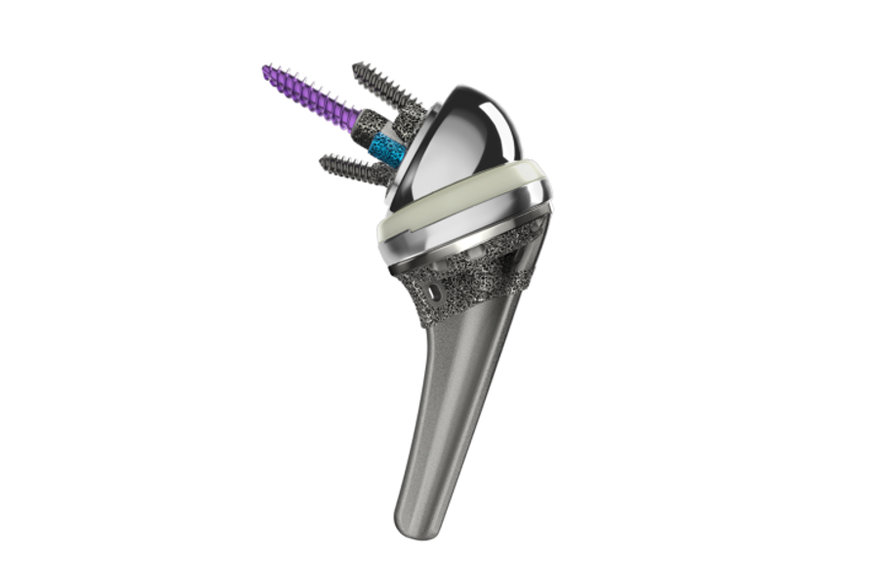www.medical-devices.tech
01
'23
Written on Modified on
INHANCE SHOULDER SYSTEM: A NEW OPTION FOR REVERSE SHOULDER REPLACEMENT SURGERY
The INHANCE Shoulder System empowers surgeons to treat a broad range of cases with a streamlined, comprehensive implant offering that features common instrumentation and unique interoperative flexibility.

Last year, following clearance for its use in anatomic shoulder arthroplasty, DePuy Synthes, a Johnson & Johnson MedTech company, received clearance from the Food and Drug Administration to use its INHANCE™ Shoulder System in reverse shoulder replacement procedures. “The system is very streamlined with only two instrument trays, offering surgeons a lot of flexibility in the operating room [OR] to perform multiple functions depending on the procedure,” says Matthew Holda, Senior Marketing Director, Growth and Innovation, Shoulder Reconstruction, DePuy Synthes.
Often, he notes, a surgeon will go into a procedure intending to do a traditional shoulder replacement surgery, only to find that a patient’s rotator cuff is in bad shape. Since the Inhance Shoulder System is approved for both traditional and reverse shoulder replacements, the surgeon can make that switch in the OR, on the spot, without having to change out the system or instruments. “The hope is it will reduce the need for shoulder replacement revisions down the road,” notes Dr. Murthi. Dr. Murthi, a design surgeon who helped develop the Inhance Shoulder System and who receives royalties, is a consultant for an affiliate of DePuy Synthes.

Traditional shoulder replacement, left; reverse shoulder replacement, right
3 Things to Know About Inhance
The system’s versatility is just one of its unique characteristics. Here’s a closer look at what makes Inhance so special.
1. Flexibility and efficiency
Most patients used to spend a few days in the hospital following shoulder replacement surgery, but not anymore. “More than 90 percent of all orthopaedic procedures now are done as outpatient surgery, so patients go home the same day,” explains Dr. Murthi.
And Inhance helps make the surgery more efficient: In anatomic procedures, a stemless option is available for qualifying patients. In this case, a rod isn’t inserted into the patient's arm bone, like it is for most other shoulder replacement surgeries. This may result in up to 25 minutes less time in the OR and an up to 16% reduction in blood loss. “It means less pain, less bone loss and a faster surgery,” says Dr. Murthi.
While other shoulder replacement systems have stemless options, Inhance is the only one that allows a surgeon to use it for both a traditional and a reverse shoulder replacement. That versatility allows a surgeon a lot of flexibility in the OR.
The Inhance system also has fewer trays and fewer instruments, which not only results in cost savings per case but also reduces the amount of storage and cleaning.
2. A unique design
“The number-one complication with reverse shoulder replacements is dislocation,” says Dr. Murthi. The Inhance implant itself has a 135-degree neck shaft angle, and “the hope is that it’s a more stable construct, so it will be less likely to get dislocated over time,” he adds. It’s also designed in a way to reduce the number of surgical steps.
What’s more, the glenoid implant itself is made of a substance called cross-linked vitamin E polyethylene, which has been shown to reduce wear and tear on the implant. As a result, shoulder replacements have the potential to last longer.
3. Potential for faster recovery
Since the implants are smaller than traditional ones, incisions are too, which potentially leads to a quicker recovery time with less disruption to surrounding muscles and tissues. “When we’ve followed patients in our registry with regular X-rays and range-of-motion and pain scores, we see the same thing consistently—an earlier return to function, and earlier pain relief,” says Dr. Murthi, who has done hundreds of these procedures over the last six to eight months.
There is one caveat: To get the best results, you need to have a home therapy program or go to formal physical therapy for around three months—and stick with it. “The key to a successful shoulder replacement is flexibility over strength,” explains Dr. Murthi. “That’s why most people require physical therapy to maintain range of motion as much as possible.” When that happens, patients are usually back to regular activities within three months. “My golfers are back on their feet and able to chip and putt at six weeks,” he says.
www.jnj.com


